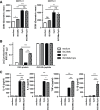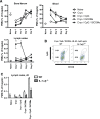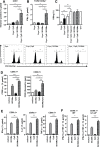Tumor ablation plus co-administration of CpG and saponin adjuvants affects IL-1 production and multifunctional T cell numbers in tumor draining lymph nodes
- PMID: 32461350
- PMCID: PMC7254152
- DOI: 10.1136/jitc-2020-000649
Tumor ablation plus co-administration of CpG and saponin adjuvants affects IL-1 production and multifunctional T cell numbers in tumor draining lymph nodes
Abstract
Background: Tumor ablation techniques, like cryoablation, are successfully used in the clinic to treat tumors. The tumor debris remaining in situ after ablation is a major antigen depot, including neoantigens, which are presented by dendritic cells (DCs) in the draining lymph nodes to induce tumor-specific CD8+ T cells. We have previously shown that co-administration of adjuvants is essential to evoke strong in vivo antitumor immunity and the induction of long-term memory. However, which adjuvants most effectively combine with in situ tumor ablation remains unclear.
Methods and results: Here, we show that simultaneous administration of cytidyl guanosyl (CpG) with saponin-based adjuvants following cryoablation affects multifunctional T-cell numbers and interleukin (IL)-1 induced polymorphonuclear neutrophil recruitment in the tumor draining lymph nodes, relative to either adjuvant alone. The combination of CpG and saponin-based adjuvants induces potent DC maturation (mainly CpG-mediated), antigen cross-presentation (mainly saponin-based adjuvant mediated), while excretion of IL-1β by DCs in vitro depends on the presence of both adjuvants. Most strikingly, CpG/saponin-based adjuvant exposed DCs potentiate antigen-specific T-cell proliferation resulting in multipotent T cells with increased capacity to produce interferon (IFN)γ, IL-2 and tumor necrosis factor-α in vitro. Also in vivo the CpG/saponin-based adjuvant combination plus cryoablation increased the numbers of tumor-specific CD8+ T cells showing enhanced IFNγ production as compared with single adjuvant treatments.
Conclusions: Collectively, these data indicate that co-injection of CpG with saponin-based adjuvants after cryoablation induces an increased amount of tumor-specific multifunctional T cells. The combination of saponin-based adjuvants with toll-like receptor 9 adjuvant CpG in a cryoablative setting therefore represents a promising in situ vaccination strategy.
Keywords: CD8-positive T-lymphocytes; adaptive immunity; adjuvants, immunologic; dendritic cells; immunomodulation.
© Author(s) (or their employer(s)) 2020. Re-use permitted under CC BY-NC. No commercial re-use. See rights and permissions. Published by BMJ.
Conflict of interest statement
Competing interests: None declared.
Figures




Similar articles
-
Saponin-based adjuvants create a highly effective anti-tumor vaccine when combined with in situ tumor destruction.Vaccine. 2012 Jan 17;30(4):737-44. doi: 10.1016/j.vaccine.2011.11.080. Epub 2011 Nov 30. Vaccine. 2012. PMID: 22138178
-
The Application of Cytidyl Guanosyl Oligodeoxynucleotide Can Affect the Antitumor Immune Response Induced by a Combined Protocol of Cryoablation and Dendritic Cells in Lewis Lung Cancer Model.Med Sci Monit. 2016 Apr 19;22:1309-17. doi: 10.12659/msm.898194. Med Sci Monit. 2016. PMID: 27092689 Free PMC article.
-
ISCOMATRIX adjuvant combines immune activation with antigen delivery to dendritic cells in vivo leading to effective cross-priming of CD8+ T cells.J Immunol. 2011 Jul 1;187(1):55-63. doi: 10.4049/jimmunol.1004114. Epub 2011 May 25. J Immunol. 2011. PMID: 21613613 Free PMC article.
-
Adjuvants Enhancing Cross-Presentation by Dendritic Cells: The Key to More Effective Vaccines?Front Immunol. 2018 Dec 13;9:2874. doi: 10.3389/fimmu.2018.02874. eCollection 2018. Front Immunol. 2018. PMID: 30619259 Free PMC article. Review.
-
Multiple effects of immunostimulatory DNA on T cells and the role of type I interferons.Springer Semin Immunopathol. 2000;22(1-2):77-84. doi: 10.1007/s002810000028. Springer Semin Immunopathol. 2000. PMID: 10944802 Review.
Cited by
-
Saponin nanoparticle adjuvants incorporating Toll-like receptor agonists drive distinct immune signatures and potent vaccine responses.Sci Adv. 2024 Aug 9;10(32):eadn7187. doi: 10.1126/sciadv.adn7187. Epub 2024 Aug 7. Sci Adv. 2024. PMID: 39110802 Free PMC article.
-
Saponin-based adjuvant uptake and induction of antigen cross-presentation by CD11b+ dendritic cells and macrophages.NPJ Vaccines. 2025 Jan 22;10(1):15. doi: 10.1038/s41541-024-01056-y. NPJ Vaccines. 2025. PMID: 39843492 Free PMC article.
-
Immune Modulation Plus Tumor Ablation: Adjuvants and Antibodies to Prime and Boost Anti-Tumor Immunity In Situ.Front Immunol. 2021 Apr 14;12:617365. doi: 10.3389/fimmu.2021.617365. eCollection 2021. Front Immunol. 2021. PMID: 33936033 Free PMC article. Review.
-
NSAIDs affect dendritic cell cytokine production.PLoS One. 2022 Oct 13;17(10):e0275906. doi: 10.1371/journal.pone.0275906. eCollection 2022. PLoS One. 2022. PMID: 36227963 Free PMC article.
-
Progress in the cryoablation and cryoimmunotherapy for tumor.Front Immunol. 2023 Jan 25;14:1094009. doi: 10.3389/fimmu.2023.1094009. eCollection 2023. Front Immunol. 2023. PMID: 36761748 Free PMC article. Review.
References
Publication types
MeSH terms
Substances
LinkOut - more resources
Full Text Sources
Research Materials
